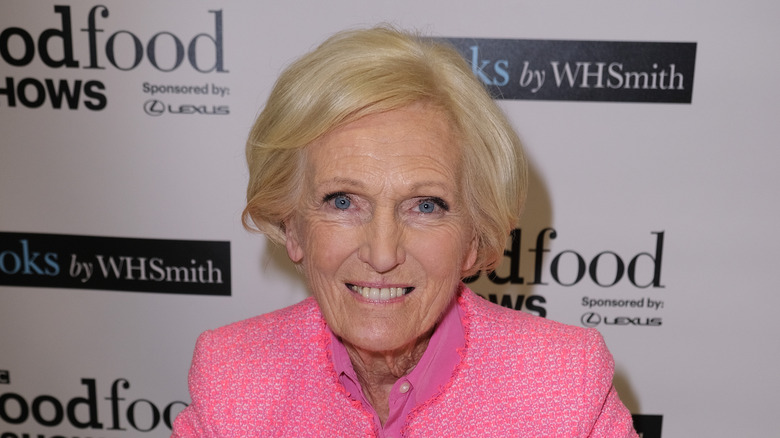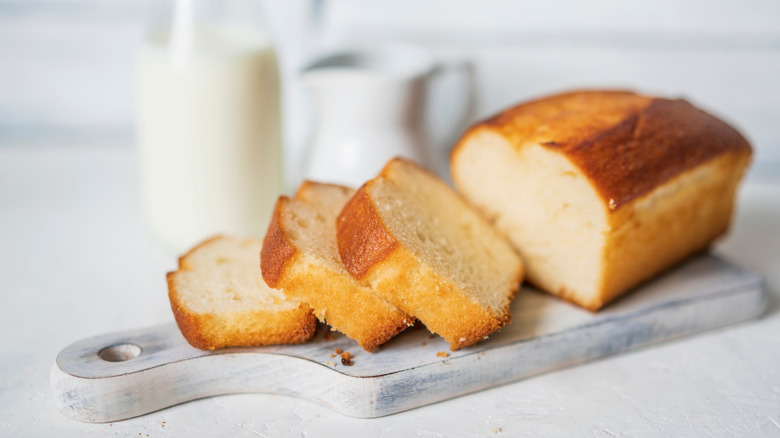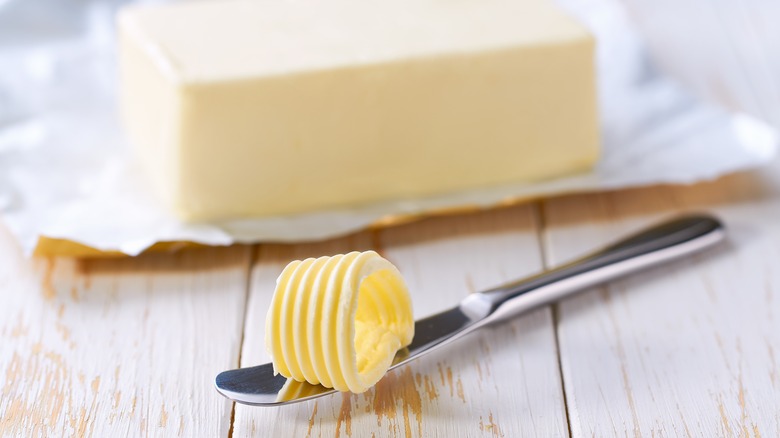Mary Berry's Butter Tip To Bake Superior Cakes
When it comes to baking, it's worth heeding Mary Berry's advice. Besides being a former judge on "The Great British Bake Off," she has decades of culinary experience, spanning from her training at Le Cordon Bleu to her 70 cookbooks. And if there's one particular recipe that Berry is known for, it's her Victoria sponge cake. The simple yet scrumptious dessert is a classic tea-time treat that only requires a few ingredients, including butter — a staple cooking fat that deserves special attention.
Whether you're preparing a sponge cake or a pound cake, the butter you use can make or break the quality of your bake. That's why Mary Berry shared a tip for choosing it, specifically emphasizing to check the amount of butterfat in a given stick or spread before bringing it home from the store. "I always aim [for] over 75%. The problem with lower fat spreads and butters is they have a higher water content. When it evaporates it causes layers [to] bind together in your mix," she wrote for BBC Good Food. Butter that's higher in fat tends to be better for achieving a crumb structure that's soft and moist. But butter quality also affects flavor, too.
Berry added that finding butter with a higher fat content isn't an issue in Britain (nor in Europe more broadly). But in the United States where butterfat standards are slightly lower, it's certainly worth checking the ingredients to make sure you're buying the best butter for your cakes.
The importance of high butterfat for (most) cakes
To better understand Mary Berry's advice, we should cover some basics on cake texture. When butter is creamed correctly with sugar for a batter, the result is a tender, delicate crumb structure. And while butter does add moisture to the bake, high water content isn't a good thing. That's because butter and several of its substitutes, aptly referred to as shortenings for the fats' ability to "shorten" gluten strands, actively delay gluten from absorbing water and developing. Butter with less fat and more water can interfere with aeration, over-hydrating the cake to the point that it's dense and stodgy.
The problem that Berry poses is one that many bakers are familiar with: Not all butter is churned equally. Per USDA standards, butter sold in the States has to have a fat content of at least 80%; meanwhile, the EU mandates it must contain between 82% and 90% butterfat and no more than 16% water. Accordingly, if butter has 2% less fat, this discrepancy may be accounted for with 2% more water, which directly affects the flavor and texture of your bakes.
While American-style butter exceeds Mary Berry's recommended 75% butterfat content, European-style butter is generally regarded as the best option for butter-centric bakes. This includes pastries made with laminated dough (think croissants or Danishes), pie crusts, and butter cakes. Not only does a higher-fat butter improve a pound cake's texture, for instance, but it also grants the simple cake a richer flavor.
High-fat butter isn't always necessary for bakes
While many cakes and other baked goods benefit from higher amounts of fat, the source of it doesn't always have to be butter. Besides margarine, which can be made from vegetable oils ranging from corn to soybean, sunflower oil is another neutral-flavored substitute — and one of Mary Berry's go-to baking oils. In particular, she prefers it for her veggie-packed sunshine cake and her moist chocolate cake with beetroot — one of Prince Louis' favorite desserts. Compared to butter's 80% to 90% fat content, this plant-based alternative is 100% fat and a good source of vitamin E.
Still, there are cakes that don't benefit from any cooking fat whatsoever. For instance, angel food cake and chiffon cake — two examples of unshortened cakes — contain little to no fat, so Mary Berry's butter tip isn't as useful for these desserts. To still achieve a light, fluffy texture, both meringue-based foam cakes are leavened by air rather than butter paired with chemical leavening agents. Chiffon cake's creamy yellow hue, which is commonly achieved in bakes through butter, is instead made possible by egg yolks.
However, there are other uses for richer butter besides baking cakes. For instance, the buttercream frosting that's piped into Mary Berry's Victoria sponge sandwich will be extra flavorful and creamy when made with butter that's higher in fat. So, even if you don't bake butter-based cakes all too often, high-fat butter may still deserve a spot in your fridge for other sweet creations.


